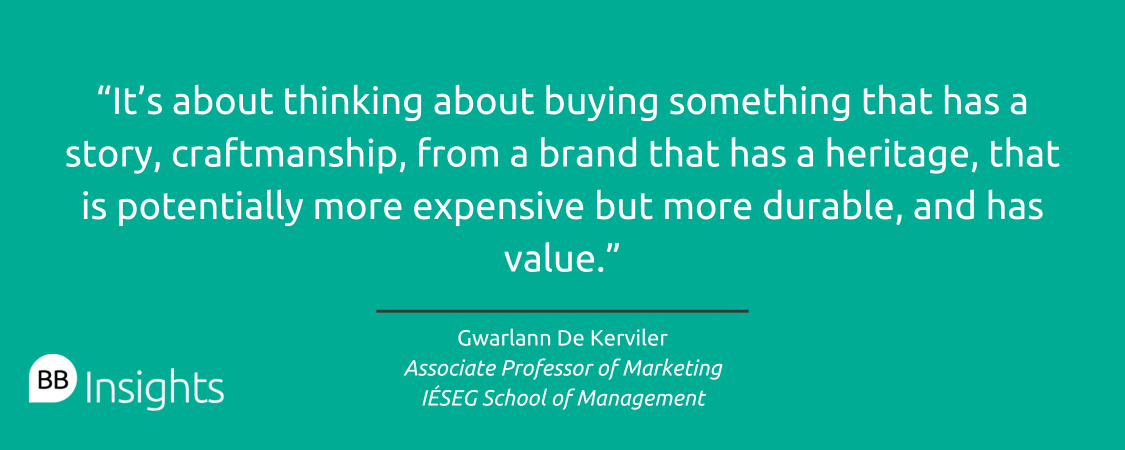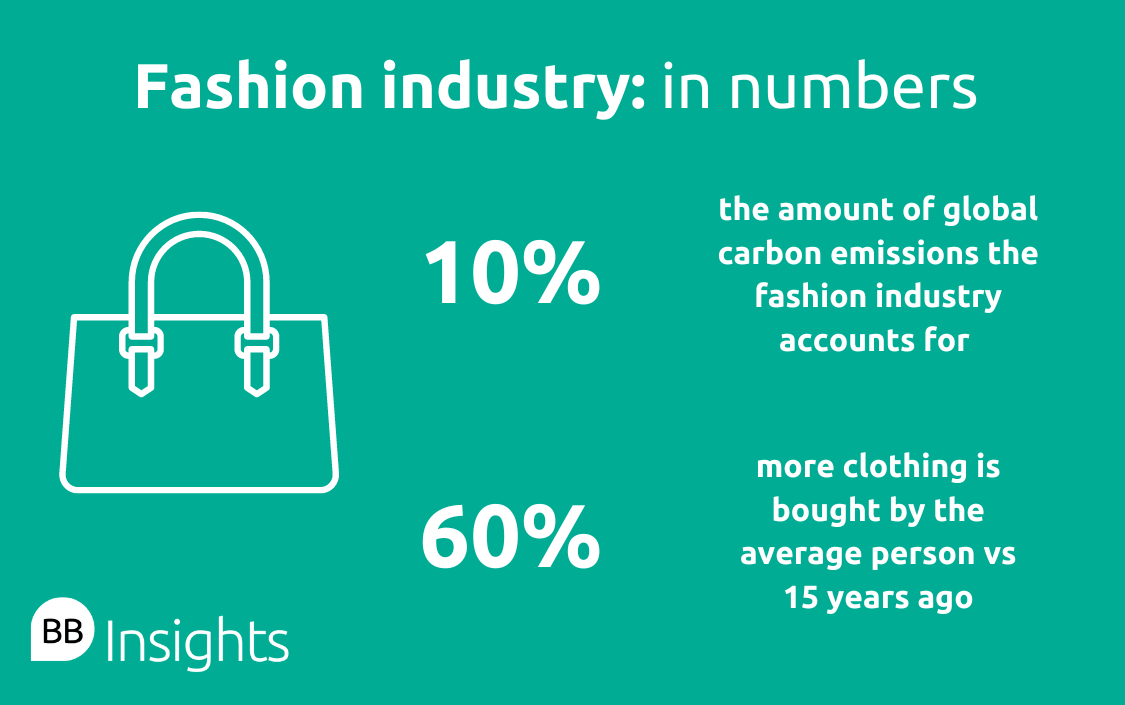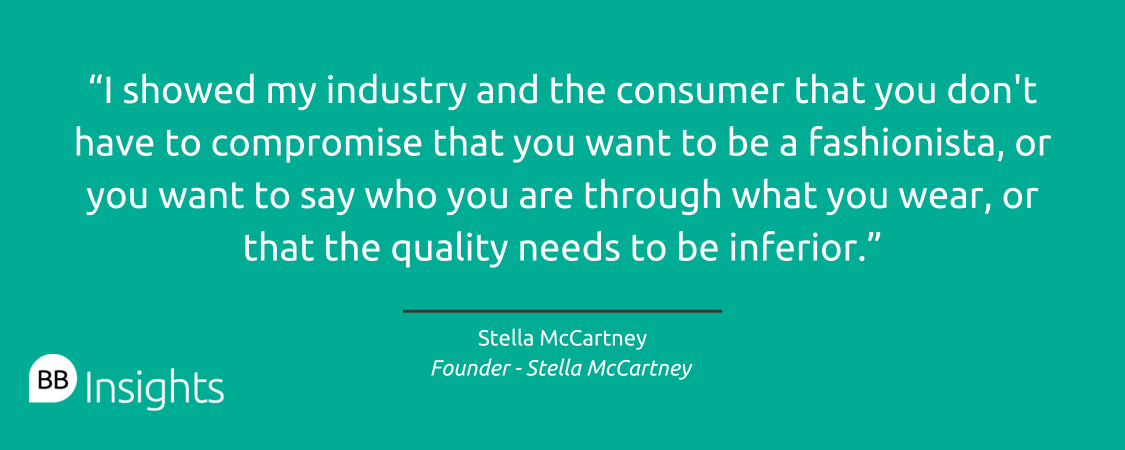Scrolling through Instagram can often feel no different to browsing a fashion website. As you click past influencers modelling the latest trends, suddenly the items hung up in your wardrobe dramatically lose all appeal.
After all, anyone who grew up watching The Lizzie McGuire Movie would know that, once upon a time, the sin of all sins in the fashion world was to be brandished an ‘outfit repeater’.
Yet, thankfully, the tides are turning. There are more and more sustainable fashion influencers on social media apps such as TikTok, with its savvy users known to champion authenticity in representation.
The last few years have marked a growing movement towards thrift shops, which have now become the go-to place to find vintage fashion pieces without the hefty price tag.
Considering more than just trends, why is sustainable fashion important? What is the real-world environmental impact of the fashion industry? BusinessBecause spoke to a marketing and consumer behavior expert at IÉSEG School of Management to find out more.
Gwarlann De Kerviler is associate professor of marketing at IÉSEG School of Management in Paris. She graduated from Harvard Business Schools and teaches Brand Management Strategy, Luxury Marketing, and Market Research to MBAs and Executives.
The relationship between fashion and sustainability
The fashion industry accounts for 10% of global carbon emissions, according to the United Nations Environment Programme (UNEP).
The fast fashion industry—the sale of low-cost fashionable items usually sold by large brands—is the second largest polluter globally.
Gwarlann from IÉSEG has extensive expertise in consumer behavior within luxury products, brand authenticity, and ethicality.
“Much of the impact of the fashion industry comes from the production side—brands often use toxic dyes or heavy metals in their clothing—as well as the use of low paid workers in emerging countries,” she explains.
In the production of clothing, trees are raised for cellulose fabrics, with non-organic cotton farms depleting soil.
There is also the environmental impact related to the shipping and delivery of products to consumers.
“There’s this increment of always consuming more, so it’s not just the production and the delivery that’s the issue, but the amount of production that leads us to question why we are producing so many clothes because it’s not correlated with an increase in the overall number of people,” she says.
The average person now buys around 60% more items of clothing than they did 15 years ago but only keeps these items for half as long, according to data from UNEP.
This comes as major fast fashion brands such as Shein, for example, grow at an exponential rate. The Chinese fashion brand is rapidly making its mark on fashion capitals across the world, with the brand set to file for a £50 billion London listing.
The role of social media in fashion and sustainability
The demand for variety in clothing is encouraged by the fashion industry with many high street fashion stores continually changing their collections to meet the unsatiable appetite of consumers.
“There is a push for changing your clothes very often, so having the latest trend, switching all the time, changing the color, the style, the type, by occasion and by year,” says Gwarlann.
Since clothing and fashion are closely aligned with identity, this can lead to a feeling among consumers that they need to continually look different to retain a sense of social capital.
Barbara Kruger’s famous 1990 artwork ‘I shop therefore I am’ represents this idea, visually representing the notion that individuals can be defined by what they own.
“In today’s world, it’s a lot about your image, your audience, your capacity to attract an audience is your social status,” says Gwarlann.
The social media pages of fashion influencers, celebrities, and public figures tend to be adorned by the individual in question wearing new items of clothing, especially when they are sponsored by different brands. This can create an unrealistic, and unhealthy, attitude towards levels of consumption.
“Status is not so much about possession—it’s about accessing things and being able to track interest and generate an audience by uploading selfies and telling stories about yourself.
“Clothes are a part of this—by changing your clothes, bags, style, you generate the reason for people to follow you or regularly visit your profile,” adds Gwarlann.
Sustainable fashion brands
Despite the deep flaws in the fashion industry, there are brands that are working to address these problems through ethical fashion or ‘slow fashion’ practices.
“There are many brands that are trying to improve their production, reduce overconsumption, and create more durable clothing using more natural materials such as wool and cotton, or trying to make sure that they source from producers who do not have pesticides and chemicals, for example, in their raw materials,” explains Gwarlann.
As a reaction to the widely accepted acknowledgement of the problems of the fashion industry, there are also brands that are using sustainable fashion as part of their marketing strategy, appealing to an audience of ethically minded consumers.
Levi Jeans’ ‘Buy Better, Wear Longer’ campaign promotes the idea of buying clothing that’s designed to last and that can be passed from generation to generation. The brand offers to repair jeans within the lifecycle of the garment and offers advice articles on repairing and upcycling Levi Jeans, ensuring that their values align with their campaign message.
In the sports fashion world, Adidas is making waves. The sports powerhouse publishes an annual sustainability report and since 2024, the brand has aimed to replace virgin polyester with recycled polyester.
Outdoor clothing brand Patagonia is another example of a sustainable fashion brand, with all of Patagonia’s profits going towards tackling climate change.

Changing consumer behavior in sustainable fashion
Nowadays, there are also more legal and regulatory constraints that bind the fashion industry to sustainability practices, with more and more brands housing dedicated sustainability departments.
“The idea is to encourage slow fashion advice in terms of quality over quantity. To take the time to appreciate the environment, to know about the brand, its history, its treatment of its workers, and to be ready to buy from brands that have less economies of scale but provide products that you can use for a longer period,” says Gwarlann.
However, for customers, the temptation can be to buy cheaply and often due to convenience.
While Generation Z have often been accused of fueling Shein’s global dominance as a fast fashion powerhouse with their trend for clothing try-on hauls on social media, the average Shein customer is actually a 35-year-old woman who spends around $100 per month on clothes. This rejects common assumptions that fast fashion consumption is restricted to young, low-income consumers.
“How you transition consumers from buying something in a hedonic way—because it’s cheap and easy—to making a conscious choice about your responsibility and your carbon impact in your purchasing habits can be challenging,” says Gwarlann.
Innovative approaches to secondhand fashion are emerging, such as clothing rental websites such as Hurr and By Rotation, which offer consumers the opportunity to rent luxury or high-end fashion pieces for a short period of time.
Gwarlann is reluctant to hail these as a solution to the problem. “Rental platforms can still nourish this idea of constantly having a different item with you. This doesn’t solve the problem as people still accumulate clothing and this feeds the exchange industry,” she says.
Consumers also need to be wary of potential greenwashing. A Environmental Research Letters study found that renting clothes had the highest climate impact among five different ways of owning and disposing of clothes.
Gwarlann believes that business schools have a role to play in helping students understand more about their environmental impact as consumers.
“Business schools have a responsibility to educate students as future consumers or current customers, to be aware that they are part of the problem and that they need to alter their consumer behavior,” she says.
Innovations in sustainable fashion
With business schools’ opportunity to educate students as consumers and future business leaders of fashion companies, they can help breed innovation and creativity in sustainable fashion.
As part of the 2023 student social entrepreneurship business competition hosted by Hult International Business School, Yale students won a $1 million prize for creating a banana waste leather startup.
When Stella McCartney was approached in early 1997 to lead as designer at French luxury fashion brand Chloé, she defiantly told executives that there was to be no use of fur or leather. This was, at the time, a bold and radical statement that would later position her as a forward-thinking champion of sustainable fashion.
Speaking to finalists at the 2023 Hult Prize, Stella McCartney advised that the only way to make a difference in sustainable fashion is to create a healthy business alternative.
“I showed my industry and the consumer that you don't have to compromise that you want to be a fashionista, or you want to say who you are through what you wear, or that the quality needs to be inferior.
“I think what I have done is I've provided an alternative solution that stands shoulder-to-shoulder,” she said.
Her namesake brand Stella McCartney Company creates bestselling luxury handbags made from synthetic leather and faux suede.
The London-born designer also champions social entrepreneurs and invests in innovations in areas such as sequins grown from algae and plastic-free leather alternatives, as well as replanting trees in a forest in Sweden.
Gwarlann from IÉSEG explains that consumers can increasingly seek out brands harnessing innovation and creativity in sustainable fashion.
“It’s about thinking about buying something that has a story, craftmanship, from a brand that has a heritage, that is potentially more expensive but more durable, and has value,” she says.
An example of an innovative solution in sustainable fashion comes from Bottletop—a UK-based luxury sustainable fashion brand that recycles bottle tops to create unique bags.
Yet Gwarlann warns that it’s not always easy for sustainable fashion companies.
“There’s a risk for companies focused on sustainability that people do not associate your product with desirability but companies such as Bottletop are combining sustainability and desirability,” she says.
She also adds that it takes time for companies to find responsible suppliers, which can limit their creativity. Choosing responsibly can additionally limit the materials and colors a brand can use, making its items feel less trendy or cool.
There is also then the issue for companies that by consumers buying fewer but more durable products, customers will then buy the products less often.
She advises that a potential solution might be for companies to manage a portfolio of products so that there is a mix of iconic yet staple products that people don’t have to switch often but then giving consumers a reason to go back to the brand with collections that rotate.
“You need a balance and to be realistic,” warns Gwarlann.
Sustainable fashion influencers on TikTok
As Gen Z’ers turn to TikTok apps in search of authenticity, there is an increase in sustainable fashion influencers who use the platform to analyze the sustainability of fashion brands and provide recommendations on shopping responsibly and exploring circular fashion.
Brett Staniland, a former UK Love Island reality star, has made his name on TikTok as a sustainable fashion advocate who uses his platform to hold fast fashion brands such as Boohoo and Pretty Little Thing to account.
“By giving students and young people the knowledge, helping them to find brands and understand how they can purchase better, then these same people will be interested in such influencers and potentially become sustainable fashion influencers themselves,” says Gwarlann.
These same authenticity seeking users are also the ones who are quick to point out when brands that pride themselves on sustainability do not live up to their values.
In 2023, influencer-turned-entrepreneur Grace Beverley published a TikTok video that she had sold one million (GBP) worth of items within an hour from her activewear brand TALA. A social media furor ensued as users were quick to question how her brand could be positioned as sustainable when selling a high volume of clothing in quick succession.
The future of fashion and sustainability
Despite consumer understanding of the environmental impact of the fashion industry, this does not always translate into action in terms of changing consumer behavior and purchasing habits.
“If customers don't change, it's going to be hard for companies to do something that is not valued by customers,” says Gwarlann.
Voting with your feet will be important for upholding the fashion industry to account yet companies also need to work with consumers to create sustainable products that are desirable and have less impact on the environment if a truly circular model of sustainable fashion is to be achieved.
“[Sustainable fashion] may come with a cost, which is taking the time to select, to choose, and to understand what's behind the product, and potentially paying a premium for something you will appreciate more,” concludes Gwarlann.





